COMMENT OF THE DAY: HOW TO HELP CANINO’S NET THAT DESTINATION FISH MARKET APPEAL 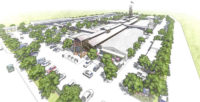 “Something that seems to make other markets around the world such successful destinations (Pike Place, Borough Market, Reading Terminal, etc.) is their accessibility within a dense urban core. In each case, the locations are accessible to pedestrians and located near high-traffic public transit locations. They are also near other walkable destinations like stores and restaurants, art galleries and museums; within walking distance from hotels and other destinations. It will be interesting to see how this works out in Houston on Airline Dr., with all of the car traffic and expansive space needed to accommodate parking. I hope Airline and Cavalcade get to be a little more walkable, and buses run there more often.” [Nearnort, commenting on Destination-Ization Plans for Airline Dr. Farmers Market Show New Rooftops, Playground, Multistory Observation Tower, Some Whitewashing] Rendering of plans for Canino Market on Airline Dr.: MLB Capital Partners
“Something that seems to make other markets around the world such successful destinations (Pike Place, Borough Market, Reading Terminal, etc.) is their accessibility within a dense urban core. In each case, the locations are accessible to pedestrians and located near high-traffic public transit locations. They are also near other walkable destinations like stores and restaurants, art galleries and museums; within walking distance from hotels and other destinations. It will be interesting to see how this works out in Houston on Airline Dr., with all of the car traffic and expansive space needed to accommodate parking. I hope Airline and Cavalcade get to be a little more walkable, and buses run there more often.” [Nearnort, commenting on Destination-Ization Plans for Airline Dr. Farmers Market Show New Rooftops, Playground, Multistory Observation Tower, Some Whitewashing] Rendering of plans for Canino Market on Airline Dr.: MLB Capital Partners
Tag: Density
COMMENT OF THE DAY: HOW HOUSTON GOT ITS SPRAWL, AND OTHER TALES OF PSEUDOZONING 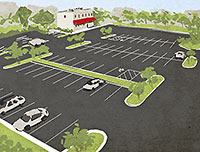 “Blame our city’s efforts at ‘planning’ in lieu of zoning. In the early 70’s, due to insufficient wastewater infrastructure, the city enacted a ban on apartment buildings of more than 4 units inside the Loop (driving much of apartment development to Uptown and Meyerland) and enforced a 5000-sq.-ft. minimum lot size. This gave rise to the Montrose 4-plex (of which there are still some examples remaining), but put a cap on residential density inside the loop. Then in the 1980’s, we got 25-ft building setbacks, followed by mandatory minimum parking requirements. This added a cap on commercial density to go with the cap on residential density. The rest is history: for the next couple of decades, the car became the focal point of the built environment, and we became the low-density city we are today. With repeal of some of the more retrograde density caps we’re starting to get some residential density, but setbacks and parking minimums are still getting in the way of the necessary commercial density needed for real walkability.” [Angostura, commenting on Comment of the Day: No, Sprawl’s Not Just a Number After All] Illustration: Lulu
“Blame our city’s efforts at ‘planning’ in lieu of zoning. In the early 70’s, due to insufficient wastewater infrastructure, the city enacted a ban on apartment buildings of more than 4 units inside the Loop (driving much of apartment development to Uptown and Meyerland) and enforced a 5000-sq.-ft. minimum lot size. This gave rise to the Montrose 4-plex (of which there are still some examples remaining), but put a cap on residential density inside the loop. Then in the 1980’s, we got 25-ft building setbacks, followed by mandatory minimum parking requirements. This added a cap on commercial density to go with the cap on residential density. The rest is history: for the next couple of decades, the car became the focal point of the built environment, and we became the low-density city we are today. With repeal of some of the more retrograde density caps we’re starting to get some residential density, but setbacks and parking minimums are still getting in the way of the necessary commercial density needed for real walkability.” [Angostura, commenting on Comment of the Day: No, Sprawl’s Not Just a Number After All] Illustration: Lulu
COMMENT OF THE DAY: HOUSTONIANS WOULDN’T KNOW DENSITY IF IT PARKED RIGHT IN FRONT OF THEM  “This is exactly what happens in every dense city. If you go to Brooklyn, you will see cars street-parked in front of the brownstones. Few of those cars belong to the resident of the brownstone immediately adjacent. They recognize that they don’t own the street parking in front of their residence. It’s an incredible waste of resources to require that those perfectly good parking spaces remain vacant, in favor of large separate parking structures.” [Heightsresident, commenting on Comment of the Day: How To Tilt The Zero-Sum Houston Transit Game] Illustration: Lulu
“This is exactly what happens in every dense city. If you go to Brooklyn, you will see cars street-parked in front of the brownstones. Few of those cars belong to the resident of the brownstone immediately adjacent. They recognize that they don’t own the street parking in front of their residence. It’s an incredible waste of resources to require that those perfectly good parking spaces remain vacant, in favor of large separate parking structures.” [Heightsresident, commenting on Comment of the Day: How To Tilt The Zero-Sum Houston Transit Game] Illustration: Lulu
COMMENT OF THE DAY: SAVE-THE-DOME SAGA’S PARKING GARAGE ENDING LEAVES ROOM FOR A SEQUEL 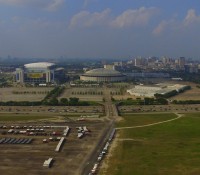 “I think people are missing the larger view here. Of course there is plenty of current surface parking — but putting parking beneath the Dome begins to open up the possibility of densification on this site and on the old Astroworld site. This is the first, and necessary, step in transforming this entire area. I am betting that in 20 years or so this site will barely resemble the vast wasteland of parking lots and open space that it is today.” [SH, commenting on County Approves First $10.5 Million for Astrodome Basement Parking Garage Plan] Photo: Russell Hancock via Swamplot Flickr Pool
“I think people are missing the larger view here. Of course there is plenty of current surface parking — but putting parking beneath the Dome begins to open up the possibility of densification on this site and on the old Astroworld site. This is the first, and necessary, step in transforming this entire area. I am betting that in 20 years or so this site will barely resemble the vast wasteland of parking lots and open space that it is today.” [SH, commenting on County Approves First $10.5 Million for Astrodome Basement Parking Garage Plan] Photo: Russell Hancock via Swamplot Flickr Pool
COMMENT OF THE DAY: WHY DENSITY DOESN’T WORK IF YOU’RE THE ONLY ONE DOING IT 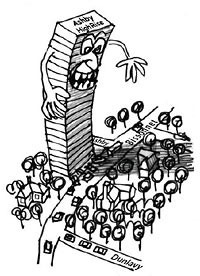 “I used to think the whole ‘Tower of Traffic’ slogan was BS — that greater density will increase walkability and reduce the need for cars. However, the way many highrises are sited in Houston completely eliminates the benefits of a highrise. They basically become vertical culs-de-sac, still car-dependent, because each one is located in pockets of lowest land value either next to freeways or in the middle of single-family-home neighborhoods. If I recall correctly, city council or the planning department passed a rule that forces developers to stick to building heights that are close to those of neighboring structures. Is this really the case? I think it’s a great way to better cluster high-density developments and walkable areas.” [Derek, commenting on A Bird’s-Eye View of the ExxonMobil Campus; The Ashby Highrise Effect] Illustration: Stop Ashby Highrise
“I used to think the whole ‘Tower of Traffic’ slogan was BS — that greater density will increase walkability and reduce the need for cars. However, the way many highrises are sited in Houston completely eliminates the benefits of a highrise. They basically become vertical culs-de-sac, still car-dependent, because each one is located in pockets of lowest land value either next to freeways or in the middle of single-family-home neighborhoods. If I recall correctly, city council or the planning department passed a rule that forces developers to stick to building heights that are close to those of neighboring structures. Is this really the case? I think it’s a great way to better cluster high-density developments and walkable areas.” [Derek, commenting on A Bird’s-Eye View of the ExxonMobil Campus; The Ashby Highrise Effect] Illustration: Stop Ashby Highrise
COMMENT OF THE DAY: IT’S NOT THE SIZE OF INFRASTRUCTURE, IT’S HOW YOU USE IT  “This is less about the size and population of cities, and more about growth and how it’s handled. . . . Growth has terrible problems; rapid growth makes those problems worse, and poor planning makes them worse. But the alternative of urban decline is far worse than even rapid, poorly planned growth. It’s easy to complain about traffic and overcrowded schools, higher housing costs and overextended public services. But would you really rather live with a decaying, unused infrastructure that local government can’t afford to maintain, and schools that are shutting down and neglected? Would you rather watch as the tax base erodes and the City government goes defunct? Would you want to sell your house at a steep loss? Not me. Look at Chicago. Look at what Detroit went through. Sure, the traffic jams are a thing of the past, but at what cost? One other thing to note is that small cities and rural areas can struggle with growth, too. Look at what happened in Karnes County when the Eagle Ford Shale boom was going on. They had problems with traffic, dangerous roads, a lack of housing and skyrocketing prices, overcrowded schools . . .” [ZAW, commenting on Comment of the Day: Drawing a Line on Urban Expansion] Illustration: Lulu
“This is less about the size and population of cities, and more about growth and how it’s handled. . . . Growth has terrible problems; rapid growth makes those problems worse, and poor planning makes them worse. But the alternative of urban decline is far worse than even rapid, poorly planned growth. It’s easy to complain about traffic and overcrowded schools, higher housing costs and overextended public services. But would you really rather live with a decaying, unused infrastructure that local government can’t afford to maintain, and schools that are shutting down and neglected? Would you rather watch as the tax base erodes and the City government goes defunct? Would you want to sell your house at a steep loss? Not me. Look at Chicago. Look at what Detroit went through. Sure, the traffic jams are a thing of the past, but at what cost? One other thing to note is that small cities and rural areas can struggle with growth, too. Look at what happened in Karnes County when the Eagle Ford Shale boom was going on. They had problems with traffic, dangerous roads, a lack of housing and skyrocketing prices, overcrowded schools . . .” [ZAW, commenting on Comment of the Day: Drawing a Line on Urban Expansion] Illustration: Lulu
COMMENT OF THE DAY: ON THE OTHER SIDE OF THE TRACKS 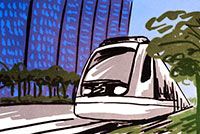 “The love affair with trains by a certain group of urbanists in the US is a ‘grass is greener on the other side’ mentality; they always point how wonderful public transport is in Europe. Well, if you actually lived in you Europe (and I have for many years), you realize that public transport is a horrible pain in the ass to live with every day. It’s inefficient if you have to go anywhere that is not on direct route, you have to make plans days in advance if you need to be across town at a particular time, you have to go to the market every F-ing day to buy food because you can’t carry more than a couple of bags at a time. You eventually give up after a while and end up confining your life to within a couple of blocks of your house. Don’t even get me started when the weather is bad. There’s one thing everyone in dense European cities dreams of: owning a car.” [commonsense, commenting on Which Came First: the Traffic or the Freeway Lanes?] Illustration: Lulu
“The love affair with trains by a certain group of urbanists in the US is a ‘grass is greener on the other side’ mentality; they always point how wonderful public transport is in Europe. Well, if you actually lived in you Europe (and I have for many years), you realize that public transport is a horrible pain in the ass to live with every day. It’s inefficient if you have to go anywhere that is not on direct route, you have to make plans days in advance if you need to be across town at a particular time, you have to go to the market every F-ing day to buy food because you can’t carry more than a couple of bags at a time. You eventually give up after a while and end up confining your life to within a couple of blocks of your house. Don’t even get me started when the weather is bad. There’s one thing everyone in dense European cities dreams of: owning a car.” [commonsense, commenting on Which Came First: the Traffic or the Freeway Lanes?] Illustration: Lulu
WHICH CAME FIRST: THE TRAFFIC OR THE FREEWAY LANES? 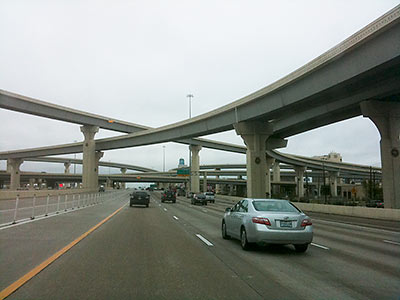 “Population growth doesn’t happen independently of transportation infrastructure—it’s profoundly shaped by it,” writes Daniel Hertz over at City Observatory this week. Hertz’s commentary comes in response to pushback following an article in which the blog weighed the outcome of the Katy Freeway’s 2008 expansion (calling out 30- and 55-percent increases in morning and afternoon commute times between 2011 and 2014). Pro-expansion readers purportedly commented that while travel times along the corridor did actually get worse, those same slowdowns would have been even stickier had the expansion not taken place when it did. But that’s backwards, argues Hertz, or at least a simplification: “In fact, research dating back at least to the 1950s has found over and over that highway construction in the urban periphery is associated with more housing construction there—and the depopulation o[f] urban neighborhoods. . . . Part of the way that highways fill themselves up with cars is by creating demand for housing near them.” [City Observatory, previously on Swamplot] Photo of I-10 West: Andres Lombana [license]
“Population growth doesn’t happen independently of transportation infrastructure—it’s profoundly shaped by it,” writes Daniel Hertz over at City Observatory this week. Hertz’s commentary comes in response to pushback following an article in which the blog weighed the outcome of the Katy Freeway’s 2008 expansion (calling out 30- and 55-percent increases in morning and afternoon commute times between 2011 and 2014). Pro-expansion readers purportedly commented that while travel times along the corridor did actually get worse, those same slowdowns would have been even stickier had the expansion not taken place when it did. But that’s backwards, argues Hertz, or at least a simplification: “In fact, research dating back at least to the 1950s has found over and over that highway construction in the urban periphery is associated with more housing construction there—and the depopulation o[f] urban neighborhoods. . . . Part of the way that highways fill themselves up with cars is by creating demand for housing near them.” [City Observatory, previously on Swamplot] Photo of I-10 West: Andres Lombana [license]
COMMENT OF THE DAY: SCOOTING ON OVER FOR THE FUTURE  “In 1860 the population density of NYC was 3,891 people per square mile. Houston today is 3,371. Were there a bunch of people in NYC around 1860 decrying the densification of NY to 11,381 by 1900? I’m not saying that Houston is like NYC but the world is only filling up with more people. In 1940 there were only a little over 2 billion people on the planet . . . today there are over 7 billion people. It is insane to think that the world, especially cities, are not going to change and become much much denser to accommodate this growth. What else are we going to do? Where are all these people going to live? The inner loop of Houston is where all of the action is at . . . demand is driving this. Some cities help mitigate a lot of the growing pains with comprehensive plans . . . I guess Houston has Swamplot and the invisible hand . . .” [Duston, commenting on Trio of Houses Across from Black Hole on Castle Ct. Is Coming Down] Illustration: Lulu
“In 1860 the population density of NYC was 3,891 people per square mile. Houston today is 3,371. Were there a bunch of people in NYC around 1860 decrying the densification of NY to 11,381 by 1900? I’m not saying that Houston is like NYC but the world is only filling up with more people. In 1940 there were only a little over 2 billion people on the planet . . . today there are over 7 billion people. It is insane to think that the world, especially cities, are not going to change and become much much denser to accommodate this growth. What else are we going to do? Where are all these people going to live? The inner loop of Houston is where all of the action is at . . . demand is driving this. Some cities help mitigate a lot of the growing pains with comprehensive plans . . . I guess Houston has Swamplot and the invisible hand . . .” [Duston, commenting on Trio of Houses Across from Black Hole on Castle Ct. Is Coming Down] Illustration: Lulu
COMMENT OF THE DAY: SORRY, BUT HOUSTON’S NEVER GONNA BE WALKABLE 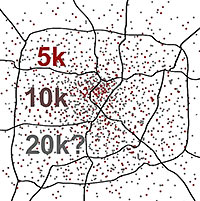 “Unlikely Houston will ever have the density or transit similar to the world’s great urban centers. The inner loop would have to triple in density (current average 5-8k/sq.mi), just to start on that path. Houston is growing, but I don’t see the population tripling any time soon. Think about how many housing units would be required; where would they go? In the predominantly single family neighborhoods? At best, the current trend will continue for a few more years until growth plateaus, and we’ll see Houston basically as it looks now; houses with occasional 4-8 story apt. blocks, maybe reaching ~10k density in some areas, but never the 20k+ necessary for real walkable neighborhoods.
Also, the heat and humidity. That’s never going away.” [outtahere, commenting on Comment of the Day: Downtown Orthodontia] Illustration: Lulu
“Unlikely Houston will ever have the density or transit similar to the world’s great urban centers. The inner loop would have to triple in density (current average 5-8k/sq.mi), just to start on that path. Houston is growing, but I don’t see the population tripling any time soon. Think about how many housing units would be required; where would they go? In the predominantly single family neighborhoods? At best, the current trend will continue for a few more years until growth plateaus, and we’ll see Houston basically as it looks now; houses with occasional 4-8 story apt. blocks, maybe reaching ~10k density in some areas, but never the 20k+ necessary for real walkable neighborhoods.
Also, the heat and humidity. That’s never going away.” [outtahere, commenting on Comment of the Day: Downtown Orthodontia] Illustration: Lulu
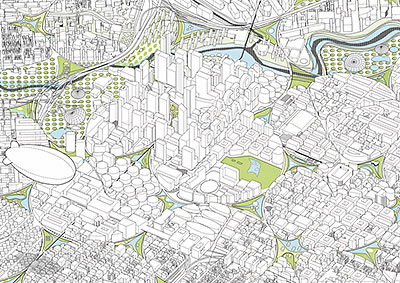
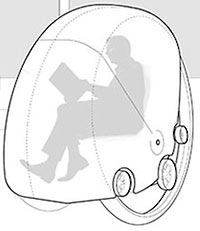
The folks over at Alloy Build think they’ve got a way to fix Houston and other sprawling cities like it: Get rid of the cars! The average vehicle, Alloy Build finds, just sits there doing nothing in a parking space for 21 hours a day. Why not use that space for something else? Once the cars are gone, the Boston design consultancy and think tank supposes, parking lots and garages and surface roads won’t be necessary anymore, either, freeing up all the wasted space in not-quite-dense-enough areas like Downtown to be grouped into dense, walkable “city cells” (i.e. neighborhoods). You’d have your office, your gym, your wine bar all right there inside your cell: It’s called “Shuffle City.”
It’s a little fanciful, the notion that Houstonians would just give away their cars. How would we get around? Well, “Shuffle City” is based on the assumption that we would freely relinquish the “ownership model” in favor of a system of shared self-propelled people-moving pods (shown at right) tracking along designated routes that encircle those “city cells.” Why drive, when you can pod? These appear to work the same way iTunes does: You can select the destination you want — Office, Gym, Vinoteca — or you can shuffle and see where the thing takes you. You know: For fun!
COMMENT OF THE DAY RUNNER-UP: HOW AND WHERE HOUSTON’S GONNA FIT ALL THOSE NEWCOMERS 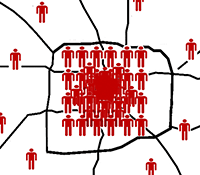 “More density is coming to the Heights and every other Inner Loop neighborhood, because the economic factors at work are unstoppable. Barring a disaster wrecking Houston (natural or otherwise) or an economic crash, more people are coming, and lots of them will want to live near the central parts of the city. All we’re debating is how that will happen. Will needed infrastructure improvements happen? Will there be better transit? Will the density be added in a way to preserves the original neighborhood, and what does that look like?
I have no problem with this kind of development along Yale or Studewood. I think an ideal outcome is main streets with good transit access and dense housing, retail, etc. with historically significant neighborhoods preserved nearby. I think what Arlington County, VA has done along these lines stands as an excellent example.
And the idea that renters bring a neighborhood down is just stupid. unless your idea of a dynamic Heights is one where the average age is 50.” [John (another one), commenting on A Second Midrise Alexan Planned Right Beside the First One on Yale] Illustration: Lulu
“More density is coming to the Heights and every other Inner Loop neighborhood, because the economic factors at work are unstoppable. Barring a disaster wrecking Houston (natural or otherwise) or an economic crash, more people are coming, and lots of them will want to live near the central parts of the city. All we’re debating is how that will happen. Will needed infrastructure improvements happen? Will there be better transit? Will the density be added in a way to preserves the original neighborhood, and what does that look like?
I have no problem with this kind of development along Yale or Studewood. I think an ideal outcome is main streets with good transit access and dense housing, retail, etc. with historically significant neighborhoods preserved nearby. I think what Arlington County, VA has done along these lines stands as an excellent example.
And the idea that renters bring a neighborhood down is just stupid. unless your idea of a dynamic Heights is one where the average age is 50.” [John (another one), commenting on A Second Midrise Alexan Planned Right Beside the First One on Yale] Illustration: Lulu
COMMENT OF THE DAY: FIRST WE CROWD “. . . those folks thinking Houston would ever actually be capable of creating infrastructure to adequately manage increased density developments are living in a fool’s paradise. you live in a state where voters actively vote against such propositions by favoring no income taxes and keeping the pressure on no property tax increases to fund such transit initiatives. the density will have to come first, that’s a given.” [joel, commenting on Comment of the Day: Bring It On]
COMMENT OF THE DAY: SAYING GOODBYE TO THE SLEEPY INNER LOOP “This complaining about what urban core growth will do to traffic and parking (make it worse / more difficult) is long past repetitive. It IS the middle of a growing, thriving city folks. Easy traffic in areas like the Heights and Montrose was an accidental luxury offered as a result of those areas having stagnated at low densities for so many decades until they were rediscovered by the market at large. Having a good connected street grid helped too (compare to major thoroughfare-and-cul-de-sac suburbs where congestion is nightmarish as soon as the subdivisions and strip malls are finished). But now the urban core is desirable, more investment, more people with disposable income, and yes, cars. Are we somehow supposed to be different from congested Los Angeles (which has much better transit and pedestrian infrastructure, by the way)? Will congestion in our central neighborhoods hurt your fondness for Houston? I seriously doubt it. We’re a great city. And if it bothers you enough to leave, three others who are quite willing to live with the traffic will replace you. And if we ever improved walkability and transit service enough, it would be six more people.” [Local Planner, commenting on Stealing a Glance at Proposed Alexan Heights on Yale]
COMMENT OF THE DAY: THE DRIVE TOWARD A DENSER HOUSTON “Density is fine as long as it’s Not In My Back Yard. Hey, that’s catchy, someone should come up with an acronym for that. in all seriousness, though, there is a transit issue with density that’s related to the character of Houston’s approach to the car. Density in other cities works well because transit in other city cores works well. Houston is . . . working on it. The fear a lot of people have with large vertical density is that assumption that transit follows the plow, so to speak. In Houston, that can be a riskier gamble than elsewhere.” [J, commenting on Regent Square-ish Apartment Tower Possibly Breaking Ground in 2 Weeks]

